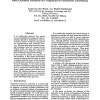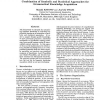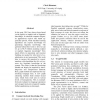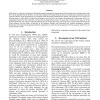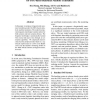EACL
1993
ACL Anthology
14 years 1 months ago
1993
ACL Anthology
It is traditionally assumed that various sources of linguistic knowledge and their interaction should be formalised in order to be able to convert words into their phonemic repres...
CASCON
1993
14 years 1 months ago
1993
In a recent paper, Gale and Church describe an inexpensive method for aligning bitext, based exclusively on sentence lengths [Gale and Church, 1991]. While this method produces su...
ANLP
1994
14 years 1 months ago
1994
The framework we adopted for customizing linguistic knowledge to individual application domains is an integration of symbolic and statistical approaches. In order to acquire domai...
ACL
2001
14 years 1 months ago
2001
We describe a biographical multidocument summarizer that summarizes information about people described in the news. The summarizer uses corpus statistics along with linguistic kno...
NAACL
2007
14 years 1 months ago
2007
In the past, NLP has always been based on the explicit or implicit use of linguistic knowledge. In classical computer linguistic applications explicit rule based approaches prevai...
LREC
2010
14 years 1 months ago
2010
In this article, we present an experiment of linguistic parameter tuning in the representation of the semantic space of polysemous words. We evaluate quantitatively the influence ...
COLING
2008
14 years 1 months ago
2008
Bracketing Transduction Grammar (BTG) is a natural choice for effective integration of desired linguistic knowledge into statistical machine translation (SMT). In this paper, we p...
ACL
2008
14 years 1 months ago
2008
In this paper, we propose a linguistically annotated reordering model for BTG-based statistical machine translation. The model incorporates linguistic knowledge to predict orders ...
AIMDM
1999
Springer
14 years 4 months ago
1999
Springer
Medical words exhibit a rich and productive morphology. Morphological knowledge is therefore very important for any medical language processing application. We propose a simple and...
NLPRS
2001
Springer
14 years 4 months ago
2001
Springer
Linguistic knowledge plays a crucial role in natural language processing. Constructing large linguistic knowledge bases requires a lot of human effort and much cost. There have b...
